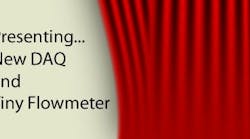Yokogawa Debuts Big DAQ Features, Tiny Coriolis Meter
Check out ControlGlobal.com on Google+
Two new Yokogawa instrumentation products were unveiled to the U.S. market this week: The powerful new SMARTDAC+ Series data acquisition systems feature modular I/O and a unique multi-touch screen. And with a pair of 0.9-mm ID vibrating tubes, the RotaMASS LR took the title of world's smallest dual-bent-tube meter. Both were unveiled at a Tuesday afternoon press conference during the Yokogawa User Group conference in New Orleans.The SMARTDAC+ digital data acquisition system looks much like a paperless video recorder, but dwarfs all others in terms of functionality, according to Steve Byrum, data acquisition product manager. Available in two sizes, as well as portable GX and GP panel-mount versions, the new stations bring some special features such as field-upgradable, modular I/O, SD memory, a real-time data web monitor and network printer report printing. They also feature a unique multi-touch interface that brings smartphone-style pinching and navigation to the data acquisition market.
"The GX and GP products are the first of a new SmartDAC+ product family," Byrom said. "They incorporate a smart user interface, smart architecture and smart functionality design principles. The fully modular I/O architecture captures all measurement and output functions and field wiring terminations within a compact field-replaceable and -upgradeable module. This means that customers can buy the functionality they need today and add more capacity when needed."
The GX10 and GX20 are NEMA 4-rated when panel-mounted. The GX10 is supplied with a 5.7-in. touchscreen and the GX20 has a 12.1-in. touchscreen. The GP10 and GP20 are portable versions designed for use in the lab or on the test bench.
Multi-Touch Screen Eases Navigation
SmartDAC+ products use unique and proprietary resistive touchscreen technology that allows swipe control and finger-pinch in/out control for fast navigation and viewing of data displays. The displays can be configured for up to six display modes with up to 20 multi-channel views. The user interface was designed by human factors engineers, who incorporated the latest thinking into the data presentation, following universal color design principles. The color selection for the highly important overview display was chosen to enhance normal data recognition and to capture the user's attention for important data such as alarm conditions. All operations begin with a single blue menu button, which calls up a screen full of touch menus for all display and operating functions. Glowing blue during normal operation, the Menu button blinks red when there is an alarm condition.
Operators have several ways to annotate the data and leave messages, including pre-stored messages, custom messages, and if they like, they can enter a freehand annotation using a pen-stylus tool—much like on an old-school paper-based chart.
The new-design modular I/O architecture allows users to add input channels and alarm relays in any combination at any time, up to the maximum for the product. Each module is accessible from the rear of the device. A 10-channel universal input module supports a full range of thermocouple, RTD and DCV sensor measurements, as well as mA inputs with external shunt resistors. A 16-channel digital input and six-channel relay output module are also available. GX and GP20 units support up to 10 modules for a capacity of 100 input channels. The smaller GP and GX10 models support up to three modules for an input capacity of 30 channels. Configuration is done through the touch setting menus on the display.
"The full modular I/O architecture means that customers can buy the functionality they need today and add more capacity when needed." Yokogawa's Steve Byrom (left) on the company's new DACSTATION+ Series (right).
GX and GP products are network-capable and can send data and PDF-formatted reports to other network devices and network-enabled printers for automatic generation of printed reports. Because the network interface is standard Ethernet, the devices support a full range of functions that include web server, FTP file transfer, email messaging and Modbus TCP client/server connectivity. The web server functions allow users to access real-time displays, including trend history, with from a standard web browser. They also can change settings in a browser-based environment with no special software.
For more functionality, Yokogawa is offering, as a free download, GA10 file viewing and configuration software. GA10 is a stand-alone product designed from the ground up to support the GX/GP products.
A New Low for Coriolis Metering
Next on the agenda was the introduction of the Rotamass LR series of Coriolis bent-tube mass flowmeters, "the world's smallest," according to Dan Peterson, Yokogawa's marketing manager for flowmeters. Maximum flow is 40 kg/h (88 lb/h) with an accuracy of 0.15% for liquids and 0.5% for gases. For density, the standard accuracy is +/- 20 g/l, which can be boosted to 1/- 3 g/l on request.
"The LR series is designed for robust service, with built in secondary containment." Yokogawa's Dan Peterson (left) on the company's diminutive ROTAMASS LR Coriolis meter(right).
It might be small, Peterson said, "but the LR series is designed for robust service, with built-in secondary containment." Maximum operating pressure is 285 bar (4,133 psi) with 400 bar (5,801 psi) on request. The secondary containment vessel is rated to 65 bar, Peterson added.
"The dual-bent-tube mass balanced design means that there is always optimal decoupling of the core measurement element, and the design is independent of both density change and installation conditions," Peterson said. "The unit is insensitive to medium and ambient temperature changes. In fact, the LR has a built-in RTD for exacting and accurate temperature measurement."

Leaders relevant to this article:







